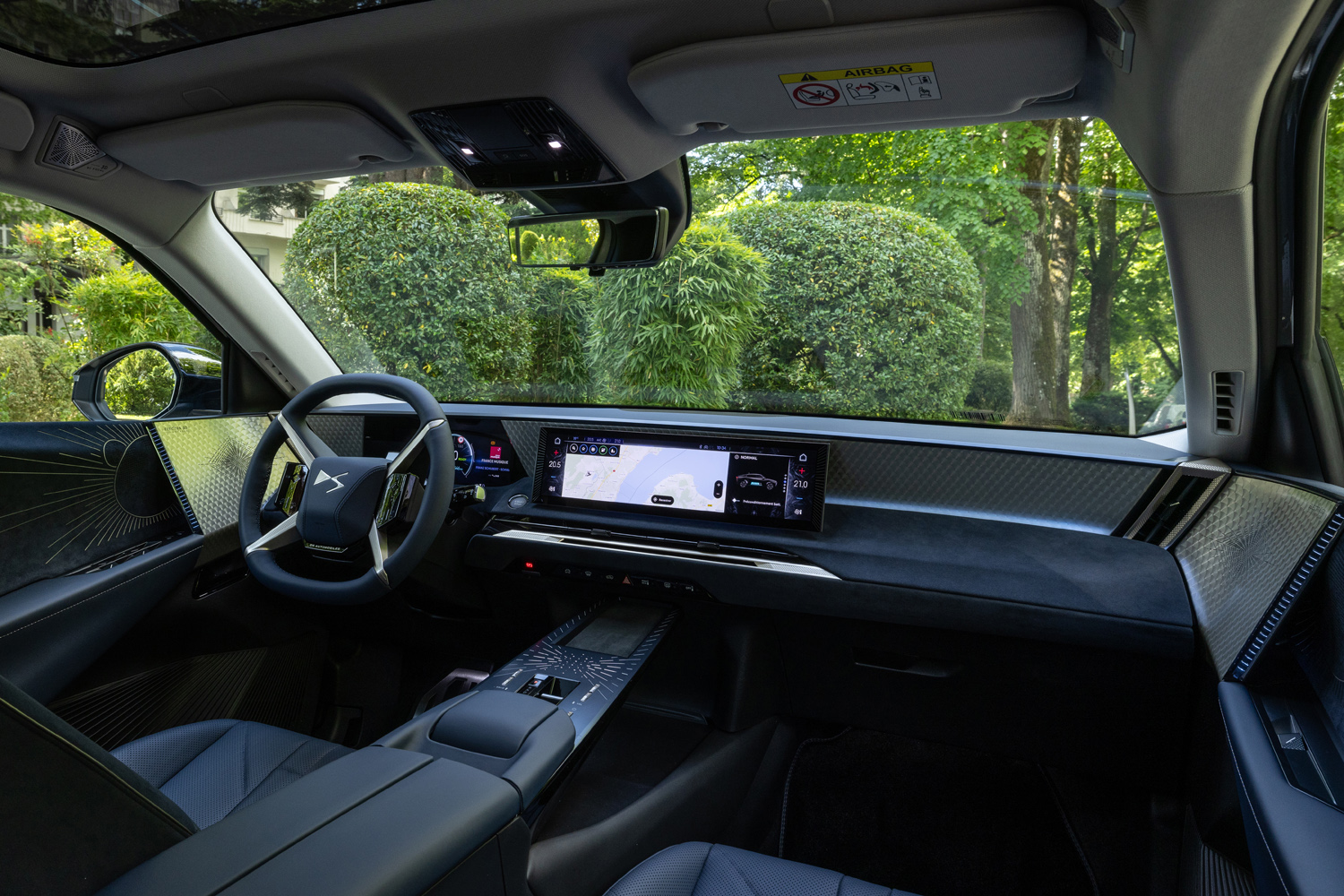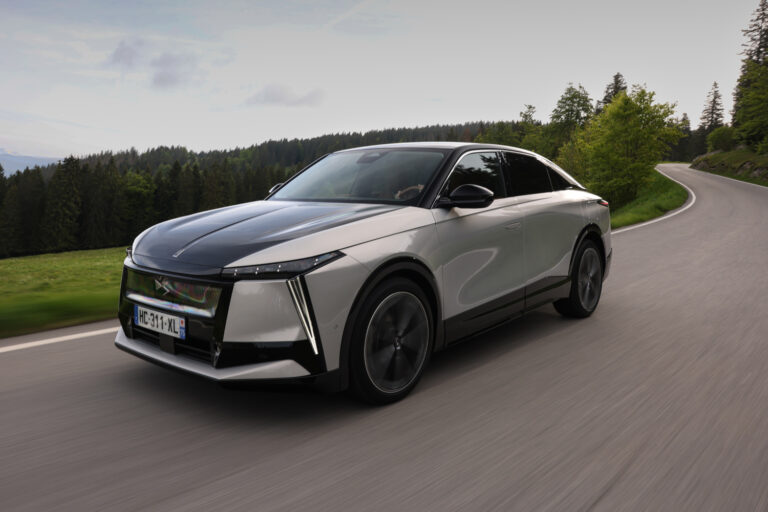Introduction
DS Automobiles always offers something a little bit different, and that’s maybe never been more true with the DS No8. This is a very individual SUV-coupe that oozes class and also packs plenty of innovation, especially when it comes to using lots of unusual materials for the interior.
It’s been designed to take on the likes of the Tesla Model Y, Audi Q6 e-tron and, interestingly, the Polestar 4, which in itself is a bit of a curio. The unmistakably French model starts at a sniff over £50,000 for the No8 Pallas trim and climbs to nearly £55,000 for the No8 Etoile. You can have a front-driven version with 230bhp, a long-range variant with 245bhp, or a three-motor, 350bhp range-topper if additional grunt is required.
The DS No8 is therefore going to be ideally suited to anyone who likes a little bit of individuality, lots of comfort and needs to munch miles on a regular basis. The biggest bonus with driving a DS is that it stands out from the crowd, and there’s no better example of that than the new No.8. Here’s how I’ve been getting on with it…
The styling
I was expecting the DS No8 to be different and, seeing it in the metal for the first time, the coupe-style exterior is a bit of a head turner. There was a lot to take in as I worked my way around the outside of this large car – it’s 4.8 metres long, although that sloping rearward roofline helps keep the profile surprisingly svelte. The acute styling looks quite dramatic, but despite its bulk the No8 has been designed with aerodynamics in mind.
Case in point is at the front end, where the carefully honed edges have been worked to cut through the air as efficiently as possible. There’s also a distinctive illuminated grille here. My only worry with this is just how much that front end would be to repair should it be damaged in an accident.
Standing back for a wider look at the DS No8, it could almost be something from the Rolls Royce stable. The use of colour is quite clever; the Crystal Pearl of my Etoile trim test car works brilliantly against the contrasting black roof, trim highlights and bonnet. The latter, incidentally, is painted using a specially developed new technique that’s similar to screen printing, eliminating overspray and thereby wastage. Another bit of innovation.
As for the deliciously minimal back-end, I think there are whiffs of the Lexus LC 500 about those taillights – no bad thing in my book. Lift the tailgate and there’s 620 litres of storage space, although there’s no frunk under the bonnet.
The DS designers have gone to town with the cockpit of this car. Although there’s quite a lot of plastic, it is balanced by the clever use of new and sustainable materials. The pictures, I think, speak for themselves.
The drive

Prior to driving the all-wheel drive No8, I spent a little time in the front-driven No8 Pallas. The latter sounded like it was being quite hard on the front tyres, even when it was being driven sedately. As a result, I found the four-wheel drive Etoile car a much more likeable thing to spend time in, even if the extra power isn’t really needed unless you’re a fan of pushing EVs to their max.
The DS No8 isn’t really that kind of car. I found it delicious to drive when taking things easy. Sure, there’s a lot of weight in evidence, which is more noticeable when it’s taking on tight bends. Overall, though, the DS No8 offers no trouble and can be handled with the minimum of effort. I was surprised how good the turning circle was too, especially given its size, and parking turns into a breeze thanks to the excellent on-screen reversing camera views.
It’s interesting to see how the square steering wheel has made a comeback and the one in the DS No8 was, I thought, surprisingly spindly. It felt good in my hands though, and elsewhere the drive mode controls are all effortless, with a range of options that, naturally, make Comfort the most obvious selection. Sport delivers a boost of fizz, and this large car will still make zero to sixty in 5.4 seconds in the AWD format. That’s fine. The Active Scan Suspension will be mighty handy on UK roads too as it uses cameras to spot irregularities in the road ahead and adjust the setup accordingly. Ideal.
The technology

A big part of the DS No8 experience revolves around the in-car entertainment. Oh sure, there’s the novelty value of Chat GPT if you want to find something out, but the sound system is where this car felt decidedly high-end. DS has collaborated with French audio specialists Focal to develop the audio setup, with no less than 14 speakers festooned around the cabin to provide a full-on sensory experience. I was mightily impressed with the way it looked and even more blown away by how it sounded.
That works in tandem with a host of other options, all designed to make any type of journey that little more soothing and stress-free. I got so much benefit from the ‘Cat paw’ massage seat mode that I was surprised I didn’t burn the electric motors out. However, it is noticeable that under the posh DS software skin, this looks to be the self-same system found in the Peugeot all-electric range, like the Peugeot E-3008 for example.
The infotainment system is centred around a 16in screen that sits nicely along the dash. There was some occasional lag from this during use, but nothing that put me off dipping in altogether. DS has kept things minimalistic when it comes to physical controls, mind, so expect to spend quite a lot of time delving into the screen’s innermost workings. Even more so if you want to peruse the delights of those massage seat settings. It’s all in there though. Somewhere.
DS No8 verdict
I was quite taken aback as to how quirky the DS No8 was. The exterior shape and novel design grew on me, and the interior – whilst being a bit wild in places – works when it’s enjoyed as a whole. Fair play to DS for keeping up with the innovation and unusual ideas, which in the main work to great effect.
I’m not quite sure how well it’ll age over time, but people probably said that about the original DS when it appeared all those years ago.
DS No8 technical specifications
| Powertrain | Permanent magnet synchronous electric motor |
| Battery | 98kWh |
| Power | 350bhp |
| Torque | 377lb-ft |
| 0-62mph | 5.4sec |
| Top speed | 118mph |
| Range | 469 miles |
| Charge rate | 160kW |
| Cargo volume | 620 litres |
Read the full article here
